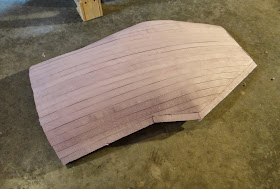With all the renovation that I have been working on in my garage to make it winter proof I have still been able to keep the progress moving along on the velomobile project. One of the things that I have had to figure out over the past months is where to mount the speedometer for the vehicle. The original placement of the speedometer was near my ankles on the TerraTrike recumbent. This worked out fine as long as I did not have to touch the speedometer for any reason. With the body of the velomobile it would be near impossible to touch the speedometer much less read it in an enclosed body. I found the solution to all of this and that is what I am going to show you here.
The speedometer mount is made up of seven different pieces as you see there. The large blue piece is the main frame of the mount. The two top pieces in red are the mating mounts for the main frame. The two yellow pieces are also mounted to the frame to hold the cylindrical spool (also in red) with an orange disk that will hold this spool in position. The speedometer has a rubber strap that wraps around this spool and is locked in place.
Here is the newly 3D printed mount assembled using standard 10-24 hardware. I have also mounted the speedometer in it's correct location. I like the look of the mount as the speedometer being all black the mount needed to be the same to make it all match perfectly.
The wire coming from the speedometer is the lead to the sensor that is mounted near the front wheel. A magnet is attached to one of the spokes and as the wheel spins the sensor picks up the magnetic field of the magnet and counts off the revolution per second and then displays the speed of the velomobile.
Here you can see how the speedometer and mount are attached to the vertical body mount on the TerraTrike for the velomobile body. The sensor wire is sent down this shaft and attached to a small mount near the spokes of the wheel. This will make reading the speedometer much easier. The mount allows for the speedometer to be position vertically, and can be rotated horizontally and vertically.
This shot gives you a much better idea of where the speedometer is located when you are sitting in the velomobile. I don't even have to remove the speedometer in order to remove or install the body from the frame of the TerraTrike. A nice thing to know when I am getting it ready for the road.
Another small assembly that I needed to get straightened out this week was the access doors that will cover the openings on the rear sides of the velomobile. (the square white openings). These access ports are needed so that it will be easier to mount or dismount the body from the TerraTrike frame.
The original doors I was thinking about were to be a plain simple door and then fiber glassed. The problem with this was the indentations on the doors for the mounting hardware to hold the door on the velomobile. Fiber glassing these little indentations would have been a pain so I went with a totally 3d printed door and added some design features to it. The mounting hardware then would be capped off with a cover to finish off the design. A good look I think.
Here you can see all of the part plus one of the 4mm machine screws for the assemblies. The eight pieces on the lower left are the finishing caps for the hardware. The other eight pieces on the lower right are the inserts for the finishing caps.
Here you can see one of the machine screws inserted into the plastic mount for one of the finishing caps. These caps snap onto place and can be removed by prying them up with a small screw driver.
Here's how the access port doors will look like once they are assembled and mounted on the velomobile. A nice clean look with just a bit of design to make it look more interesting. I will sand all of these parts smooth and then paint them to match the body.
Just a couple more things that I can cross off of my long to do list for the velomobile project. Another good week here at the Tinker's Workshop.



















































